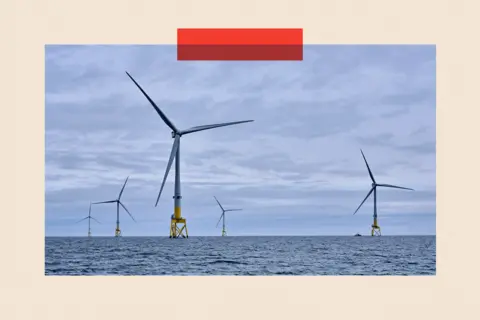
Environment Editor
 BBC
BBCIt is 1am on 3 June. A near gale force wind is blasting into Scotland. Great weather for the Moray East and West offshore wind farms, you would have thought.
The two farms are 13 miles off the north-east coast of Scotland and include some of the biggest wind turbines in the UK, at 257m high. With winds like that they should be operating at maximum capacity, generating what the developer, Ocean Winds, claims is enough power to meet the electricity needs of well over a million homes.
Except they are not.
That’s because if you thought that once an electricity generator – whether it be a wind farm or a gas-powered plant – was connected to the national grid it could seamlessly send its electricity wherever it was needed in the country, you’d be wrong.
The electricity grid was built to deliver power generated by coal and gas plants near the country’s major cities and towns, and doesn’t always have sufficient capacity in the wires that carry electricity around the country to get the new renewable electricity generated way out in the wild seas and rural areas.
And this has major consequences.
 Getty Images
Getty ImagesThe way the system currently works means a company like Ocean Winds gets what are effectively compensation payments if the system can’t take the power its wind turbines are generating and it has to turn down its output.
It means Ocean winds was paid £72,000 not to generate power from its wind farms in the Moray Firth during a half-hour period on 3 June because the system was overloaded – one of a number of occasions output was restricted that day.
At the same time, 44 miles (70km) east of London, the Grain gas-fired power station on the Thames Estuary was paid £43,000 to provide more electricity.
Payments like that happen virtually every day. Seagreen, Scotland’s largest wind farm, was paid £65 million last year to restrict its output 71% of the time, according to analysis by Octopus Energy.
Balancing the grid in this way has already cost the country more than £500 million this year alone, the company’s analysis shows. The total could reach almost £8bn a year by 2030, warns the National Electricity System Operator (NESO), the body in charge of the electricity network.
It’s pushing up all our energy bills and calling into question the government’s promise that net zero would end up delivering cheaper electricity.
Now, the government is considering a radical solution: instead of one big, national electricity market, there’ll be a number of smaller regional markets, with the government gambling that this could make the system more efficient and deliver cheaper bills.
But in reality, it’s not guaranteed that anyone will get cheaper bills. And even if some people do, many others elsewhere in the country could end up paying more.
 Getty Images
Getty ImagesThe proposals have sparked such bitter debate that one senior energy industry executive called it “the most vicious policy fight” he has ever known. He has, he says, “lost friends” over it.
Meanwhile, political opponents who claim net zero is an expensive dead end are only too ready to pounce.
It is reported that the Prime Minister has asked to review the details of what some newspapers are calling a “postcode pricing” plan. So is the government really ready to risk the most radical shake-up of the UK electricity market since privatisation 35 years ago? And what will it really mean for our bills?
Net zero under attack
The Energy Secretary, Ed Miliband, is certainly in a fix. His net zero policy is under attack like never before. The Tories have come out against it, green politicians say it isn’t delivering for ordinary people, and even Tony Blair has weighed in against it.
Meanwhile Reform UK has identified the policy as a major Achilles heel for the Labour government. “The next election will be fought on two issues, immigration and net stupid zero,” says Reform’s deputy leader Richard Tice. “And we are going to win.”
Poll after poll says cost of living is a much more important for most people, and people often specifically cite concerns about rising energy prices.
 Getty Images
Getty ImagesMiliband sold his aggressive clean energy policies in part on cutting costs. He said that ensuring 95% of the country’s electricity comes from low-carbon sources by 2030 would slash the average electricity bill by £300.
But the potential for renewables to deliver lower costs just isn’t coming through to consumers.
Renewables now generate more than half the country’s electricity, but because of the limits to how much electricity can be moved around the system, even on windy days some gas generation is almost always needed to top the system up.
And because gas tends to be more expensive, it sets the wholesale price.
Could ‘zonal’ pricing lower bills?
Supporters of the government’s plan argue that, as long as prices continue to be set at a national level, the hold gas has on the cost of electricity will be hard to break. Less so with regional – or, in the jargon, “zonal” – pricing.
Think of Scotland, blessed with vast wind resources but just 5.5 million people. The argument goes that if prices were set locally, it wouldn’t be necessary to pay wind farms to be turned down because there wasn’t enough capacity in the cables to carry all the electricity into England.
On a windy day like 3 June, they would have to sell that spare power to local people instead of into a national market. The theory is prices would fall dramatically – on some days Scottish customers might even get their electricity for free.

Other areas with lots of renewable power – such as Yorkshire and the North East, as well as parts of Wales – would stand to benefit too. And, as solar investment increases in Lincolnshire and other parts of the east of England, they could also see prices tumble.
All that cheap power could also transform the economics of industry. Supporters argue that it would attract energy-intensive businesses such as data centres, chemical companies and other manufacturing industries.
In London and much of the south of England, the price of electricity would sometimes be higher than in the windy north. But supporters say some of the hundreds of millions of pounds the system would save could be used to make sure no one pays more than they do now.
And those higher prices could also encourage investors to build new wind farms and solar plants closer to where the demand is. The argument is that would lower prices in the long run and bring another benefit – less electricity would need to be carried around the country, so we would need fewer new pylons, saving everyone money and meaning less clutter in the countryside.
 Getty Images
Getty Images“Zonal pricing would make the energy system as a whole dramatically more efficient, slashing this waste and cutting bills for every family and business in the country,” argues Greg Jackson, the CEO of Octopus Energy, one of the biggest energy suppliers in the UK.
Research commissioned by the company estimates the savings could top £55 billion by 2050 – which it claims could knock £50 to £100 a year off the average bill. Octopus points out Sweden made the switch to regional pricing in just 18 months.
The supporters of regional pricing include NESO, Citizens Advice and the head of the energy regulator, Ofgem. Last week a committee of the House of Lords recommended the country should switch to the system.
Energy firms push back
There are, however, many businesses involved in building and running renewable energy plants that oppose the move.
“We’re making billions of pounds of investments in renewable power in the UK every year,” says Tom Glover, the UK chair of the giant German power company RWE. “I can’t go to my board and say let’s take a bet on billions of pounds of investment.”
He’s worried changing the way energy is priced could undermine contracts and make revenues more uncertain. And he says it risks undermining the government’s big push to switch to green energy.
 AFP via Getty Images
AFP via Getty ImagesThe main cost of wind and solar plants is in the build. It means the price of the energy they produce is very closely tied to the cost of building and, because developers borrow most of the money, that means the interest rates they are charged.
And we are talking a lot of money. The government is expecting power companies to spend £40bn pounds a year over the next five years on renewable projects in the UK.
Glover says even a very small change in interest rates could have dramatic effects on how much renewable infrastructure is built and how much the power from it costs.
“Those additional costs could quickly overwhelm any of the benefits of regional pricing,” says Stephen Woodhouse, an economist with the consultancy firm AFRY, which has studied the impact of regional pricing for the power companies.
That would come as already high interest rates have combined with rising prices for steel and other materials to push up the cost of renewables. Plans for a huge wind farm off the coast of Yorkshire were cancelled last month because the developer said it no longer made economic sense.
 Getty Images
Getty ImagesAnd there’s another consideration, he says. The National Grid, which owns the pylons, substations and cables that move electricity around the country, is already rolling out a huge investment programme – some £60bn over the next five years – to upgrade the system ready for the new world of clean power.
That new infrastructure will mean more capacity to bring electricity from our windy northern coasts down south, and therefore also mean fewer savings from a regional pricing system in the future.
There are other arguments too. Critics warn introducing regional pricing could take years, that energy-intensive businesses like British Steel can’t just up sticks and move, and that the system will be unfair because some customers will pay more than others.
But according to Greg Jackson of Octopus, the power companies and their backers just want to protect their profits. “Unsurprisingly, it’s the companies that enjoy attractive returns from this absurd system who are lobbying hard to maintain the status quo,” he says.
Yet the power companies say Octopus has a vested interest too. It is the UK’s biggest energy supplier with some seven million customers, and owns a sophisticated billing system it licenses to other suppliers, so could gain from changes to the way electricity is priced, they claim.
And the clock is ticking. Whether the government meets its clean power targets will depend on how many new wind farms and solar plants are built.
The companies who will build them say they need certainty around the future of the electricity market, so a decision must be taken soon.
It’s expected in the next couple of weeks. Over to you, Mr Miliband.
BBC InDepth is the home on the website and app for the best analysis, with fresh perspectives that challenge assumptions and deep reporting on the biggest issues of the day. And we showcase thought-provoking content from across BBC Sounds and iPlayer too. You can send us your feedback on the InDepth section by clicking on the button below.
www.bbc.com
#huge #sums #energy #firms #provide #power






